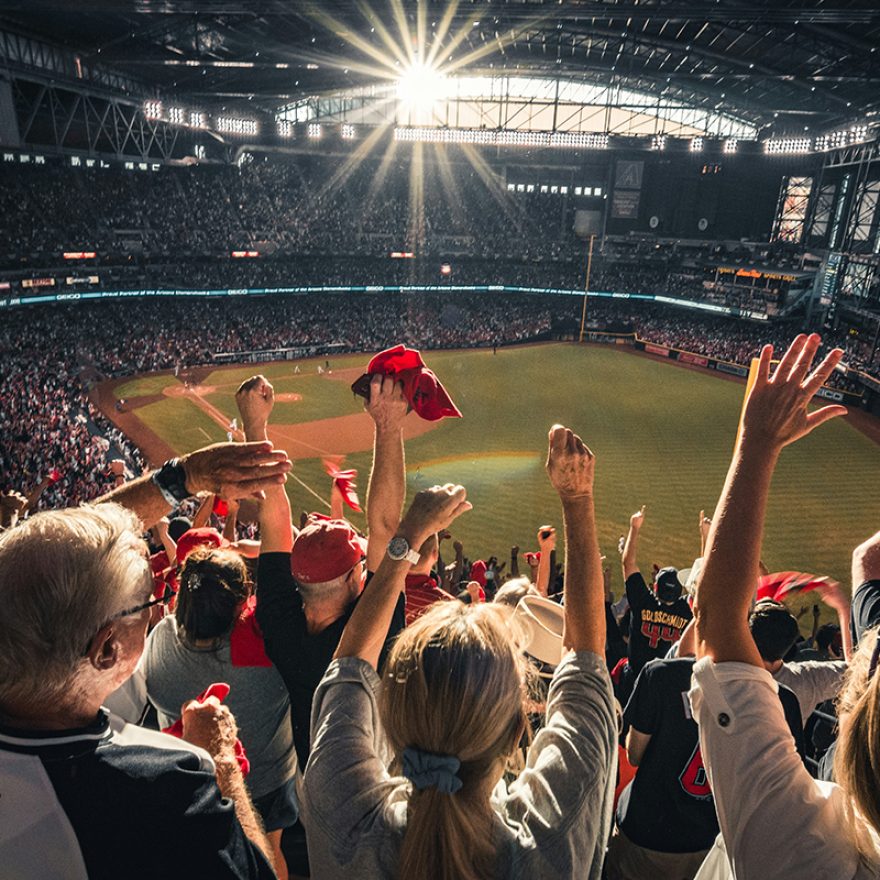
From Luxury to Loyalty: Designing for the Die-hard Sports Fan
From the desk of Hannah-Rae Ahlquist
As designers of immersive experiences, we begin each project by asking ourselves and our clients a critical question: who are we really making this for? This answer, arguably the most important catalyst for the work to follow, reveals insights that through research and deep understanding, authentically drive our decision making at every stage.
When it comes to sports experiences, our audience is undoubtedly the fan. Yet, just as we understand the tourist, the student, and the family, do we truly understand who they are? With new stadiums and sports-related experiences underway, our community claims to have the fan in mind – but who exactly does that target?
Unlike many audiences, the range of interests and levels of engagement among fans, both collectively and within a single sports fan, can vary significantly.
First, you have what we will group as experience seekers. You have your casual fans, the ones that pay attention to a team only when they reach the big games. You have your fair weather fans, the ones who lock in when the team is doing well. There are the social fans who are in it for the chants, the cheers, and social gatherings. Also, let’s not forget about the local fans who buy into the sport or team out of community pride. Finally, there is the group we all can easily pick from the crowd—the die-hards.
Die-hards are the ultimate super fan. Emotionally invested in the teams and athletes they align behind. This group feels the victories and are rocked by the losses. The die-hard sports fan regularly consumes sports related content, no matter whether live or at a venue, and no matter the form of media. This sports buff may have a deep knowledge of rules, statistics, history and current events. They collect, buy and re-buy memorabilia. They engage with like minded fans, joining online forums and engaging in discussions on social media. The sports fan is often an advocate for the sport itself. These people are in it for the love of the game, the rules, the athleticism, the competition, the rigor. Abiding by a deep commitment to all things sports.
The die-hard is the archetype most envision when they think of a sports enthusiast. This passionate individual is often depicted in commercials and referenced on social media, representing all sports fans as a whole.
With stadiums around the country upgrading to bigger, more beautiful, and flashier venues, often with outlets at every seat, less than a timeout to restock on pretzels and beer (or 5-star-dining), a plethora of 4k infinity screens, and minimal wait time to maneuver through the masses. Meaning that the lines between home and venue are blurring fast, but at an extreme risk. All of those features come with a high price tag. Nobody wants to lose the audience we so heavily value in the design process, the fan.
My husband is a life-long Dallas Cowboys fan. When he got the chance to see the Cowboys play at home in AT&T Stadium, the lasting reflection of the experience from him and his brothers was not one that magnified his feelings of being a Cowboys fan but, rather, it was one of overwhelming shock at the magnitude of the amenities, and grandiose display that was the stadium itself. It did not seem built for the fan, it felt built for the consumer.
In a modern world with experiences of every kind, large and small, from a new reel, to the latest TikTok trend, a new iOS release and venues like the Sphere making their debut, racing to compete for our attention, money and admiration, it’s a crowded attention ecosystem. The masses are used to consistent upgrades. We expect bigger and better. We want bigger and better.
But at what risk and what cost? Do sports fans care about the power outlets? How important is the food really? Are they wowed by the parking garages? If the sports fan can have Red Zone or NFL Sunday Ticket on, watching three games at once while listening to the broadcast, seeing stats on screen, scrolling past tweets from their favorite podcaster, all while being six feet away from a fully stocked fridge with their favorite drinks (at a much cheaper price), why would these fans pay to go to events at these stadiums with a high price tag when they care about the game above all else?
While stadiums assert their commitment to fans, the grandeur of these modern venues appears to lean towards consumerism and entertainment, potentially overshadowing the passion and dedication of die-hard fans. With the rise of at-home viewing options offering comprehensive coverage, there is a risk of alienating fans who prioritize the game itself over luxury amenities.
There is so much more to the story of sports, and the die-hards know that. We are squeezing two fans into the same jersey and it is not sustainable. We must craft narrative driven experiences that serve both these groups, and enhance the authenticity and depth of fan engagement beyond mere entertainment, to sustain the future of the industry.
Instead of a focus on blurring home and stadium, let us refocus, to blur the lines between analyst and fan; athlete and supporter. This will truly engage and activate the core fanbase, the tried and trues believers. Consider the experience with constantly changing in-game graphics, dramatic, immersive camera paths, unique ways of consuming and responding to live content, and even a hype-film theater.
The die-hards are the storytellers of this world. They’re the audience that if we can activate successfully long term, will unlock sports in ways no one previously. A marvelous new stadium alone is no longer enough.